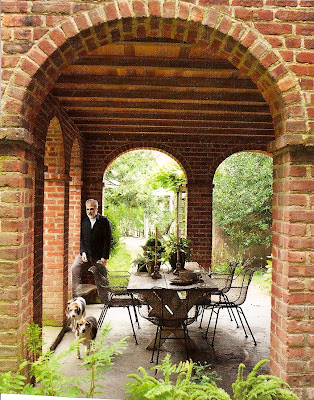The approach is the distant view. We make our way toward the approach along a path. This is the first phase of the circulation system. The approach to a building can vary in length. The nature of the approach may contrast with the building or may be a smooth transition, obscuring the distinction between inside and outside. There are three different kinds of approaches; frontal, oblique, and spiral. Frontal leads directly to the entrance of a building along a straight, axial path. Oblique enhances the effect of perspective on the front facade and form of the building. Spiral paths prolong the sequence of the approach and emphasizes the three-dimensional form of a building as we move around its perimeter. Portals and gateways have traditionally been means of orienting us to the path beyond and welcoming or guarding against entry.
 |
| Image: Davies, Roger. "All About Ease." Elle Decor. Oct. 2010. 217. |
Building Entrances
An entrance means to go from outside to inside. Entering a building, a room within a building or a defined field of exterior space, involves the act of penetrating a vertical plane that distinguishes one space from another. The act of entering can be signified in more ways than punching a hole in a wall. It may be a passage through an implied plane established by two pillars or an overhead beam. A change in level can establish a threshold and allow for greater visual and spatial continuity between the two spaces. Normally a wall is used to define and enclose a space and an entrance is created by opening a plane in the wall. The form of the opening can range from a simple hole in the wall to an elaborate, articulated gateway. Entrances can be grouped into the following categories; flush, projected, and recessed. In terms of location, an entrance can be centered within the frontal plane of a building or be placed off-center to create a condition of local symmetry about its opening.
 |
| Image: Waldron, William. "Clear Thinking." Elle Decor. Nov. 2010. 225. |
Configuration of the Path
All paths of movement are linear in nature and have a starting point, from which we are taken through a sequence of spaces to our destination. The intersection or crossing of paths is always a point of decision-making for the person approaching it. The form and scale of entrances and paths should convey the functional and symbolic distinction between public promenades, private halls, and service corridors. The nature of the configuration of a path both influences and is influenced by the organizational pattern of the spaces it links. Once we are able to map out in our minds the overall configuration of the paths in a building, our orientation within the building and our understanding of its spatial layout will be made clear. The differing configurations of paths include; linear, radial, spiral, grid, network, and composite.
 |
| Image: McCully, Martha. "What's Hot! News!" Elle Decor. Nov. 2010. 90 |
Path-Space Relationships
Path-space relationships include edges, nodes, and terminations of the path. Paths may be related to the spaces they link in the following ways; pass by spaces, pass through spaces, or terminate in a space.
 |
| Image: McCully, Martha. "What's Hot! Shops." Elle Decor. Nov. 2010. 86. |
Form of the Circulation Space
Form of the circulation space includes corridors, halls, galleries, stairways, and rooms. A circulation path may be; enclosed, open on one side, or open on both sides. The width and height of a circulation space should be proportionate with the type and amount of movement it must handle. A distinction in scale should be established between a public promenade, or more private hall, and a service corridor. A narrow, enclosed path naturally encourages forward motion. To accommodate more traffic as well as to create spaces for pausing, resting, or viewing, sections of a path can be widened. The path can also be enlarged by merging with the spaces it passes through. Within a large space, a path can be random and be determined by the activities and arrangement of furnishings within the space.
 |
| Image: Victoria. Pearson. "Collections Need Order." House Beautiful. May 2010. 141. |









